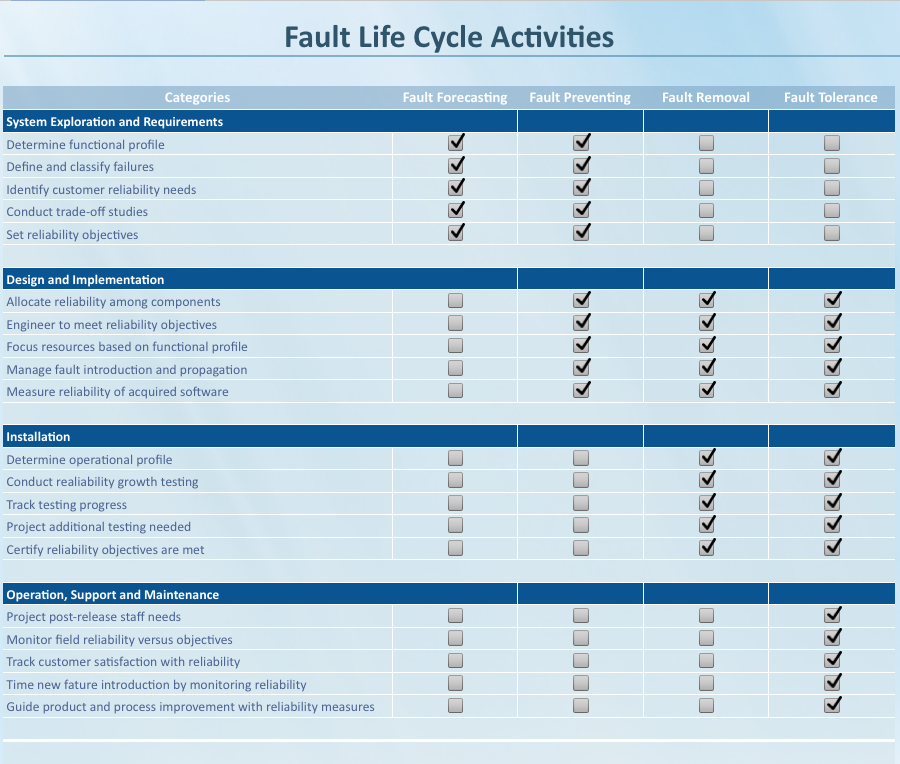Reliability design for Cloud applications
23/07/14 17:26 Filed in: Cloud architecture
On of the backbones of the software reliability is avoiding the faults. In software reliability engineering, there are four major approaches to improve system reliability.

When changing to the cloud environment, the applications deployed in the cloud are usually distributed into multiple components, only having fault prevention and fault removal techniques are not sufficient. Another approach for building reliable systems is software fault tolerance, which is to employ functionally equivalent components to tolerate faults. Software fault tolerance approach takes advantage of the redundant resources in the cloud environment, and makes the system more robust by masking faults instead of removing them.
Cloud computing platforms typically prefer to build reliability into the software. The software should be designed for failure and assumes that components will misbehave/fail or go away from time to time. Reliability should be built into application and as well as data. I.e. within the component or external module should monitor the service components and provide/execute recovery process. Multiple copies of data are maintained such that if you lose any individual machine the system continues to function (in the same way that if you lose a disk in a RAID array the service is uninterrupted). Large scale services will ideally also replicate data in multiple locations, such that if a rack, row of racks or even an entire datacenter were to fail then the service would still be uninterrupted
- Fault Forecasting: Provides the predictive approach to software reliability engineering. Measures of the forecasted dependability, can be obtained by modelling or using the experience from previously deployed systems. Forecasting is a front-end product development life cycle exercise. It is done during system exploration and requirements definition. Fault prevention: Aims to prevent the introduction of faults, e.g., by constraining the design processes by means of rules. Prevention occurs during the product development phases of a project where the requirements, design, and implementation are occurring.
- Fault removal: Aims to detect the presence of faults, and then to locate and remove them. Fault removal begins at the first opportunity that faults injected into the product are discovered. At the design phase, requirements phase products are passed to the design team. This is the first opportunity to discover faults in the requirements models and specifications. Fault removal extends into implementation and through installation.
- Fault tolerance: Provides the intrinsic ability of a software system to continuously deliver service to its users in the presence of faults. This approach to software reliability addresses how to keep a system functioning after the faults in the delivered system manifest themselves. Fault tolerance relies primarily on error detection and error correction, with the latter being either backward recovery (e.g., retry), forward recovery (e.g., exception handling) or compensation recovery (e.g., majority voting). From the middle phases of the software development life cycle through product delivery and maintenance, reliability efforts focus on fault tolerance.

When changing to the cloud environment, the applications deployed in the cloud are usually distributed into multiple components, only having fault prevention and fault removal techniques are not sufficient. Another approach for building reliable systems is software fault tolerance, which is to employ functionally equivalent components to tolerate faults. Software fault tolerance approach takes advantage of the redundant resources in the cloud environment, and makes the system more robust by masking faults instead of removing them.
Cloud computing platforms typically prefer to build reliability into the software. The software should be designed for failure and assumes that components will misbehave/fail or go away from time to time. Reliability should be built into application and as well as data. I.e. within the component or external module should monitor the service components and provide/execute recovery process. Multiple copies of data are maintained such that if you lose any individual machine the system continues to function (in the same way that if you lose a disk in a RAID array the service is uninterrupted). Large scale services will ideally also replicate data in multiple locations, such that if a rack, row of racks or even an entire datacenter were to fail then the service would still be uninterrupted